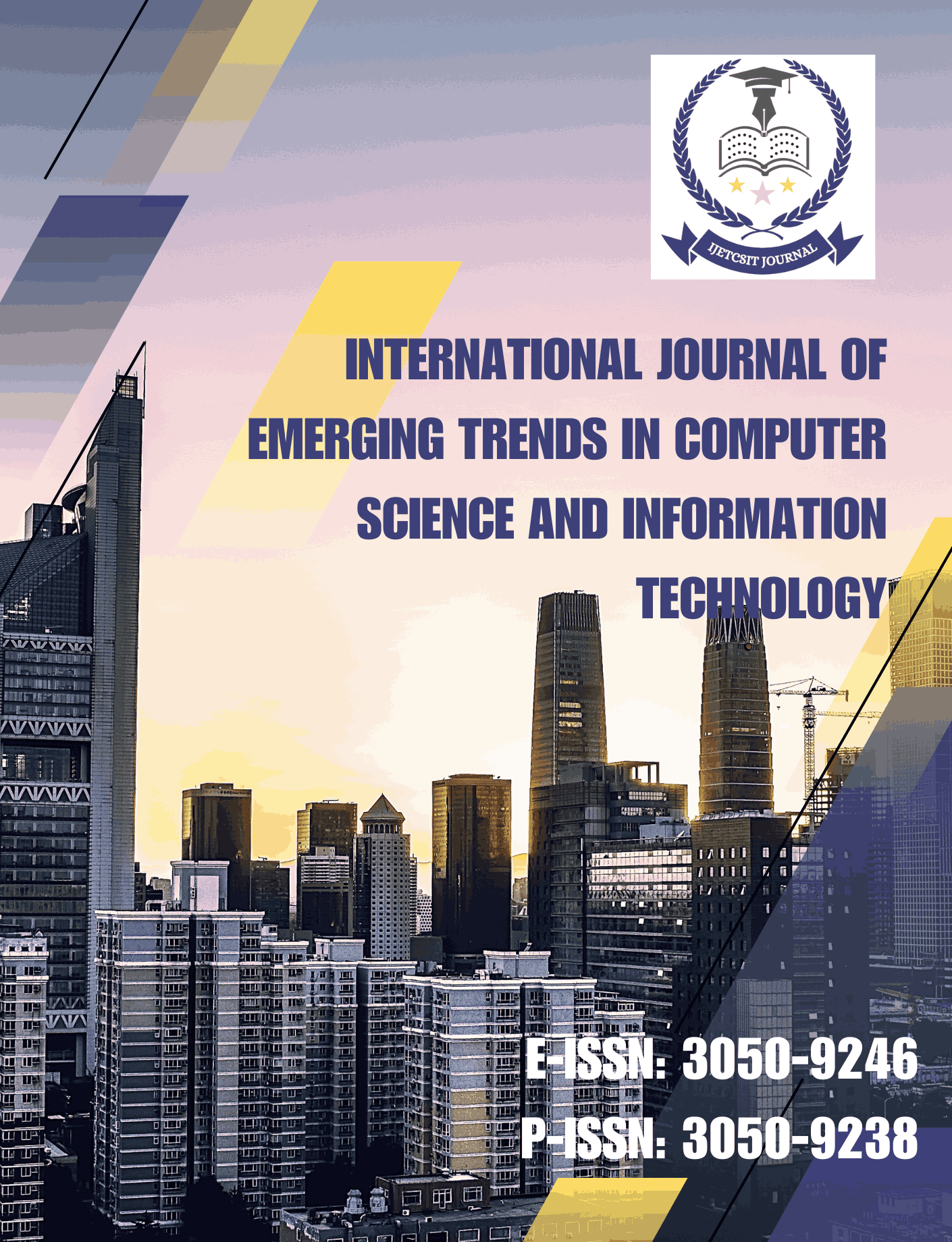Blockchain and Smart Contracts in Claims Settlement
DOI:
https://doi.org/10.63282/3050-9246.IJETCSIT-V4I2P112Keywords:
Blockchain, Smart contracts, Insurance claims, Claims settlement, zero-knowledge proofs, selective disclosure, privacy-by-design, interoperabilityAbstract
In this paper, a model is presented in the operational form of blockchain and smart contract utilization to modernise insurance claims settlement, which is enterprise-ready. Design a permissioned, Ethereum-compatible ledger that encodes policy terms limits, deductibles, exclusions and orchestrates deterministic claim state transitions from First Notice of Loss (FNOL) to payout. Off-chain storage stores sensitive artifacts (PII/PHI, images, medical records) encrypted in vaults, and on-chain records append cryptographic digests and events that can be audited by tampering evidence. This is provided by evidence (in the form of signed oracles, such as weather indices, hospital discharge summaries, police reports), and permits parametric claims to be settled quickly and routine indemnity claims to undergo high straight-through processing (STP) with human attention reserved to exceptions. The methodology emphasizes formal assurance (static analysis, property-based tests, optional formal verification), runtime safety (circuit breakers, timelocked upgrades), and robust key/oracle governance. Pilot testing in pilot testing, the methodology provides a shorter cycle time, less reconciliation, and quantifiable mitigation of fraud-leakage but still ensures regulatory compliance by selective disclosure and privacy-by-design. Also work through the dynamics of constraints throughput and fee dynamics, legal enforceability, legacy interoperability, and privacy-versus-transparency trade-off and a roadmap of staged adoption, starting with low-dispute, oracle-rich products, then triage, partial advances, and subrogation workflows. Findings indicate that blockchain is likely to be the most useful as a coordination/assurance layer to supplement, but not to substitute, fundamental insurance infrastructure
Downloads
References
[1] Hassan, A., Ali, M. I., Ahammed, R., Khan, M. M., Alsufyani, N., & Alsufyani, A. (2021). Secured insurance framework using blockchain and smart contract. Scientific Programming, 2021(1), 6787406.
[2] Karri, N. (2021). Self-Driving Databases. International Journal of Emerging Trends in Computer Science and Information Technology, 2(1), 74-83. https://doi.org/10.63282/3050-9246.IJETCSIT-V2I1P10
[3] Michaelson, P. (2020). Arbitrating disputes involving blockchains, smart contracts, and smart legal contracts. Dispute Resolution Journal, 74(4), 89-133.
[4] Nanayakkara, S., Perera, S., Senaratne, S., Weerasuriya, G. T., & Bandara, H. M. N. D. (2021, May). Blockchain and smart contracts: A solution for payment issues in construction supply chains. In Informatics (Vol. 8, No. 2, p. 36). MDPI.
[5] Crocker, K. J., & Tennyson, S. (2002). Insurance fraud and optimal claims settlement strategies. The Journal of Law and Economics, 45(2), 469-507.
[6] Karri, N., Pedda Muntala, P. S. R., & Jangam, S. K. (2025). Predictive Performance Tuning. International Journal of Emerging Research in Engineering and Technology, 2(1), 67-76. https://doi.org/10.63282/3050-922X.IJERET-V2I1P108
[7] Ren, J. (2016). Analysis of insurance claim settlement process with Markovian arrival processes. Risks, 4(1), 6.
[8] Kar, A. K., & Navin, L. (2021). Diffusion of blockchain in insurance industry: An analysis through the review of academic and trade literature. Telematics and Informatics, 58, 101532.
[9] Brophy, R. (2020). Blockchain and insurance: a review for operations and regulation. Journal of financial regulation and compliance, 28(2), 215-234.
[10] Karri, N. (2022). Leveraging Machine Learning to Predict Future Storage and Compute Needs Based on Usage Trends. International Journal of AI, BigData, Computational and Management Studies, 3(2), 89-98. https://doi.org/10.63282/3050-9416.IJAIBDCMS-V3I2P109
[11] Saeed, M., & Arshed, N. (2022). Revolutionizing insurance sector in India: A case of blockchain adoption challenges. International Journal of Contemporary Economics and Administrative Sciences, 12(1), 300-324.
[12] Wang, S., Yuan, Y., Wang, X., Li, J., Qin, R., & Wang, F. Y. (2018, June). An overview of smart contract: architecture, applications, and future trends. In 2018 IEEE intelligent vehicles symposium (IV) (pp. 108-113). IEEE.
[13] Macrinici, D., Cartofeanu, C., & Gao, S. (2018). Smart contract applications within blockchain technology: A systematic mapping study. Telematics and informatics, 35(8), 2337-2354.
[14] Karri, N. (2022). Predictive Maintenance for Database Systems. International Journal of Emerging Research in Engineering and Technology, 3(1), 105-115. https://doi.org/10.63282/3050-922X.IJERET-V3I1P111
[15] Faisandier, A. (2013). Systems architecture and design. Belberaud, France: Sinergy'Com.
[16] Joseph, B. K. (2019). Blockchain for open data–exploring conceptual underpinnings and practice. In Governance models for creating public value in open data initiatives (pp. 161-175). Cham: Springer International Publishing.
[17] Durovic, M., & Lech, F. (2019). The enforceability of smart contracts. Italian LJ, 5, 493.
[18] Neudecker, T., & Hartenstein, H. (2018). Network layer aspects of permissionless blockchains. IEEE Communications Surveys & Tutorials, 21(1), 838-857.
[19] Karri, N. (2022). AI-Powered Anomaly Detection. International Journal of Artificial Intelligence, Data Science, and Machine Learning, 3(2), 122-131. https://doi.org/10.63282/3050-9262.IJAIDSML-V3I2P114
[20] Dalipi, F., & Yayilgan, S. Y. (2016, August). Security and privacy considerations for IoT application on smart grids: Survey and research challenges. In 2016 IEEE 4th international conference on future internet of things and cloud workshops (FiCloudW) (pp. 63-68). IEEE.
[21] Maple, C. (2017). Security and privacy in the internet of things. Journal of cyber policy, 2(2), 155-184.
[22] Martinez, A., Yannuzzi, M., López, V., López, D., Ramírez, W., Serral-Gracià, R., ... & Altmann, J. (2014). Network management challenges and trends in multi-layer and multi-vendor settings for carrier-grade networks. IEEE Communications Surveys & Tutorials, 16(4), 2207-2230.
[23] Bembers, I., Jones, M., Knox, E., & Traczyk, J. (2015). Better EVMS implementation themes and recommendations. Joint Space Cost Council Themes and Recommendations.
[24] Karri, N., & Pedda Muntala, P. S. R. (2022). AI in Capacity Planning. International Journal of AI, BigData, Computational and Management Studies, 3(1), 99-108. https://doi.org/10.63282/3050-9416.IJAIBDCMS-V3I1P111
[25] Dwivedi, V., Pattanaik, V., Deval, V., Dixit, A., Norta, A., & Draheim, D. (2021). Legally enforceable smart-contract languages: A systematic literature review. ACM Computing Surveys (CSUR), 54(5), 1-34.





